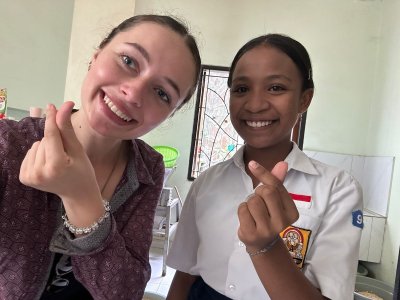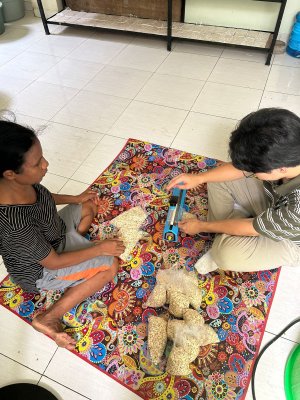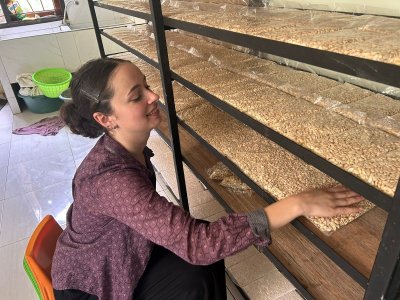The tempe from here tastes the best!
Today’s post is written by Johanna Morford-Oberst, who is doing her service at UNDANA university in Kupang, Timor.
On Tuesday, March 5th, Pak Dr. Niko, my supervisor, took Brenton, my service partner, and I to Susteran Alma Orphanage. This is a place that hosts 20 orphans as well as many staff members. They also have four pre-school classes held there. Once the kids are older than six, they have a connection with schools in the area where they can attend. We arrived and Pak Dr. Niko introduced us to Sister Astri. She introduced us to some of the teachers who teach the pre-school classes there. We visited each class and introduced ourselves to the kids. The kids greeted us with either a hug or by taking our right hand and touching it to their forehead– this is a sign of respect when greeting someone who is older than you in Indonesia. We were then taken to the teachers room where we sat and talked to one of the teachers about all that they do there. One of the four classes they host is a therapeutic class for kids with special needs. Outside, they have a large enclosed playground with colorfully painted walls where some of the parents waited to take their children home around 12pm. We then went into the dining room where more staff or people who live there gather if they have already graduated from school. Some work there making rosaries or making tempeh in their tempeh factory! We sat at the table where students made rosaries,introduced ourselves, and enjoyed some teh melati while getting to know them. Here I am with one of the students before they left for school.

The table we were gathered at was right outside of their tempeh factory and we were briefly introduced to it, but not explicitly asked to help. As tempeh enjoyers, Brenton and I decided to ask if we could help, thinking it would also be an opportunity to learn about how on earth this delicious meat alternative is made from raw soybeans. After some deliberation, we were welcomed. I began assisting with one sister putting cup fulls of soybeans – that had already been soaked, boiled twice, dried, roasted, and covered in a powder that allowed them to ferment later – into bags. This powder they called Rhizo which is a type of mold from the genus Rhizopus. All I knew before this was that tempeh was made out of something similar to tofu but fermented. I also had never tried it before I came here.
Here I am mixing the soybeans with Rhizo:

And filling bags with Tante Leni:

Then the bags were sealed with this machine that Brenton learned to use from Tante Leni:

Once the bags are sealed they are placed on a shelf where you have to distribute the contents evenly to begin the fermentation process:

After three days of sitting there, they become fermented enough to sell. They sell one bag for Rp5.000 (33 cents). We packed about 20kg of tempeh this morning which will make them around Rp1.000.000 ($66). Excitedly, Brenton and I each bought two bags for our families! And they were nice enough to give us one more for free for our help, even though we missed a lot of the process that happens much earlier in the morning.

We ended our time at the Susteran Alma Orphanage by joining them all for lunch because many of the kids had returned from their respective schools by then.

This was a very fulfilling experience to see a safe place that was created to support a community in need here in Kupang. Brenton and I, as well as our families, all agree that the tempeh from here tasted much better than any we have had before. We also both have incredible cooks in our families! I hope to be back here for longer later in my service!

A picture of Johanna and her host family in Kupang:





